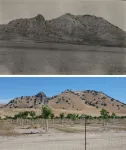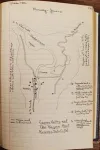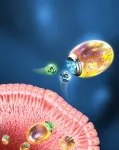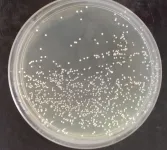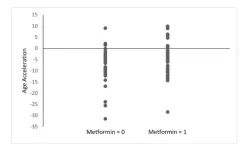(Press-News.org) Berkeley — Climate change isn’t the only threat facing California’s birds. Over the course of the 20th century, urban sprawl and agricultural development have dramatically changed the landscape of the state, forcing many native species to adapt to new and unfamiliar habitats.
In a new study, biologists at the University of California, Berkeley, use current and historical bird surveys to reveal how land use change has amplified — and in some cases mitigated — the impacts of climate change on bird populations in Los Angeles and the Central Valley.
The study found that urbanization and much hotter and drier conditions in L.A. have driven declines in more than one-third of bird species in the region over the past century. Meanwhile, agricultural development and a warmer and slightly wetter climate in the Central Valley have had more mixed impacts on biodiversity.
“It's pretty common in studies of the impact of climate change on biodiversity to only model the effects of climate and not consider the effects of land use change,” said study senior author Steven Beissinger, a professor of environmental science, policy and management at UC Berkeley and a researcher at the campus’s Museum of Vertebrate Zoology (MVZ). “But we’re finding that the individual responses of different bird species to these threats are likely to promote unpredictable changes that complicate forecasts of extinction risk.”
The study, publishing this week in the journal Science Advances, presents the latest results from UC Berkeley’s Grinnell Resurvey Project, an effort to revisit and document birds and small mammals at sites first surveyed a century ago by UC Berkeley professor Joseph Grinnell.
In the current study, the researchers resurveyed birds at 71 sites in L. A. and the Central Valley. They then used their findings — along with current and historical data on land use, average temperature and rainfall — to analyze how shifts in the climate and landscape may have contributed to changes in bird populations.
In L.A., they found that 40% of bird species were present at fewer sites today than they were 100 years ago, while only 10% were present at more sites. Meanwhile, in the Central Valley, the proportion of species that experienced a decline (23%) only slightly outnumbered the proportion that increased (16%). In many cases, opposing responses to climate and land use change by bird species, where one threat caused a species to increase while another caused the same species to decline, moderated the impacts of each threat alone.
The decline in bird species in L.A. over the past century is similar to the shocking bird community collapse that the research team documented in national parks in the Mojave Desert over the past 100 years, and linked to heat stress from climate change.
“The Central Valley had less change, in general — there were winners and losers,” Beissinger said. “Whereas in L.A., we saw mostly losers.”
Windfalls and double whammies
Grinnell was a teenager when he first started documenting birds in the late 1890s near his childhood home of Pasadena, California. He later perfected his detailed approach to surveying as a professor of zoology at UC Berkeley and the first director of the MVZ.
“In those days, they didn't have fancy binoculars. They didn't have recordings of bird calls. So, they had to get in and learn the birds through the resources that were available. Oftentimes that was from specimens in museums. Sometimes that was through popular guides or handbooks,” Beissinger said. “Grinnell was ahead of his time in the way that he was taking field notes, and he was really draconian in also making all his students take those notes.”
Grinnell’s meticulous field notes have allowed Beissinger and his team to construct a historical baseline of California’s bird life at the turn of the 20th century. The notes are so detailed that the researchers are able to reconstruct the birds encountered each day and account for the ways new technologies, such as better binoculars and field guides, have made it easier for contemporary biologists to detect birds. This analysis has allowed the team to make direct comparisons between the current and historical bird surveys.
To tease apart the disparate and sometimes opposing impacts of land use change and climate change, the researchers analyzed historical maps of urban development and agriculture to determine how the landscape at each study site had been modified during the 20th century. They also obtained historical average temperatures and rainfall at each site.
In L.A., they found that species such as Anna’s hummingbird and the American crow were able to adapt to both hotter and drier conditions and to urban development, experiencing what the researchers call a population “windfall.” Other species, such as the western meadowlark and the lark sparrow, were negatively impacted by both changes, instead experiencing a “double whammy.”
Species that experienced mixed impacts include the black phoebe, the great egret, the house wren and the blue-gray gnatcatcher.
“Our findings really highlight the fact that we’ve got climate and land use change happening at the same time, creating happy conditions for some species, while other species are declining from the same changes,” Beissinger said. “Sometimes, species might also be pushed and pulled in different directions from the climate and land use changes.”
Bird species in the Central Valley also experienced a combination of windfalls, double whammies and mixed impacts, but the proportion of species that experienced windfalls was much higher in the Central Valley than in L.A. and nearly offset the proportion that experienced double whammies.
“There are some species that have been able to persist under the agricultural changes, and some that even colonized and increased because of those changes. But they tend to be species that are more common and widespread, and the more sensitive species are the ones that started disappearing when the natural grasslands were replaced by agriculture,” Beissinger said. “In the urban areas, there are just fewer species that are able to find what they need and avoid the city hazards.”
Additional co-authors of the paper include Sarah A. MacLean of the University of La Verne and Kelly J. Iknayan and Perry de Valpine of UC Berkeley. This work was supported by grants from the National Science Foundation (DEB 1457742, DEB 1911334 and DEB 1601523), the National Geographic Society (9972-16), a UC Berkeley Chancellor’s Fellowship and a Research Professorship from the Miller Institute.
END
Climate change, urbanization drive major declines in L.A.’s birds
A new study uses current and historical bird surveys to reveal how land use change has amplified — and in some cases mitigated — the impacts of climate change on birds in Los Angeles and the Central Valley
2023-02-22
ELSE PRESS RELEASES FROM THIS DATE:
Twin-bioengine self-adaptive micro/nanorobots developed for gastrointestinal inflammation therapy
2023-02-22
Micro/nanorobots with self-propelling and -navigating capabilities have attracted extensive attention in drug delivery and therapy owing to their controllable locomotion in hard-to-reach body tissues.
However, developing self-adaptive micro/nanorobots that can adjust their driving mechanisms across multiple biological barriers to reach distant lesions is still a challenge.
Recently, a research team led by Prof. CAI Lintao from the Shenzhen Institute of Advanced Technology (SIAT) of the Chinese Academy ...
Custom, 3D-printed heart replicas look and pump just like the real thing
2023-02-22
No two hearts beat alike. The size and shape of the the heart can vary from one person to the next. These differences can be particularly pronounced for people living with heart disease, as their hearts and major vessels work harder to overcome any compromised function.
MIT engineers are hoping to help doctors tailor treatments to patients’ specific heart form and function, with a custom robotic heart. The team has developed a procedure to 3D print a soft and flexible replica of a patient’s heart. They can then ...
Professor Guido Kroemer will inaugurate Redox Medicine 2023 by Highlighting the Hallmarks of Aging & Redox Medicine
2023-02-22
The 25th International Conference on Redox Medicine, on June 21-23 in Paris, will revolutionize tomorrow’s medicine through redox. The translation of basic knowledge of redox into molecular medicine will be extensively discussed.
Prof. Guido Kroemer from the Université de Paris Cité, Hôpital Européen George Pompidou - AP-HP, is the key note speaker for this year. It is a great opportunity to share with Guido Kroemer his favorite topics and to have a unique moment of exchange with him.
Hallmarks of Aging & Redox Medicine: An Expanding Universe
Prof. Kroemer will highlight the “hallmarks of ageing: genomic instability, ...
WVU physicists give the first law of thermodynamics a makeover
2023-02-22
West Virginia University physicists have made a breakthrough on an age-old limitation of the first law of thermodynamics.
Paul Cassak, professor and associate director of the Center for KINETIC Plasma Physics, and graduate research assistant Hasan Barbhuiya, both in the Department of Physics and Astronomy, are studying how energy gets converted in superheated plasmas in space. Their findings, funded by a grant from the National Science Foundation and published in the Physical Review Letters journal, will revamp ...
Yeast used in production of cachaça can prevent asthma, study shows
2023-02-22
A daily dose of a strain of brewer’s yeast used to produce cachaça (distilled spirit made from fermented sugarcane juice) can act as a preventive against asthma, according to a Brazilian study involving male mice. The results are reported in an article published in the journal Probiotics and Antimicrobial Proteins. The authors are researchers at the University of São Paulo (USP) and the Federal University of Minas Gerais (UFMG). The yeast strain used in the study was Saccharomyces cerevisiae UFMG A-905.
Asthma is a common lung condition that causes breathing difficulties. It ...
Out of the blue
2023-02-22
(Santa Barbara, Calif.) — Blue foods — those that come from the ocean or freshwater environments — have tremendous potential to help address several global challenges. With careful implementation of policies that leverage these foods, nations could get a boost on efforts to reduce nutritional deficits, lower disease risk, decrease greenhouse gas emissions and ensure resilience in the face of climate change.
So say the team of experts at Blue Food Assessment, an international collaboration of scientists whose focus has been on the role of aquatic foods in global ...
Hands-free tech adds realistic sense of touch in extended reality
2023-02-22
HOUSTON – (Feb. 22, 2023) – With an eye toward a not-so-distant future where some people spend most or all of their working hours in extended reality, researchers from Rice University, Baylor College of Medicine and Meta Reality Labs have found a hands-free way to deliver believable tactile experiences in virtual environments.
Users in virtual reality (VR) have typically needed hand-held or hand-worn devices like haptic controllers or gloves to experience tactile sensations of touch. The new “multisensory pseudo-haptic” technology, which is described in an open-access ...
Physically demanding work tied to higher male fertility, study suggests
2023-02-22
A new study from researchers from Brigham and Women’s Hospital, a founding member of the Mass General Brigham healthcare system, suggests that men who regularly lift heavy objects at work have higher sperm counts. The study, published in Human Reproduction, is part of the Environment and Reproductive Health (EARTH) cohort, a clinical study which aims to explore how exposure to environmental chemicals and lifestyle choices affect reproductive health.
“We already know that exercise is associated with multiple health benefits in humans, including those observed on reproductive health, but few studies have looked at how occupational factors can ...
Aging | Metformin's impact on aging and longevity through DNA methylation
2023-02-22
“In this study, we compared genome-wide DNA methylation rates among metformin users and nonusers [...]”
BUFFALO, NY- February 22, 2023 – A new research paper was published in Aging (listed as "Aging (Albany NY)" by MEDLINE/PubMed and "Aging-US" by Web of Science) Volume 15, Issue 3, entitled, “Metformin use history and genome-wide DNA methylation profile: potential molecular mechanism for aging and longevity.”
Metformin, a commonly prescribed anti-diabetic medication, has repeatedly been shown to hinder aging in pre-clinical ...
As sea ice declines in the Arctic, bowhead whales are adjusting their migration patterns
2023-02-22
NEWPORT, Ore. – As sea ice declines in the Arctic, bowhead whales are staying north of the Bering Strait more frequently, a shift that could affect the long-term health of the bowhead population and impact the Indigenous communities that rely on the whales, a new study by Oregon State University researchers shows.
Bowhead whales found in the Pacific Arctic, sometimes called Bering-Chukchi-Beaufort bowheads based on their migratory patterns, normally winter in the northern Bering Sea and migrate north in the spring through the Bering Strait to the Canadian Beaufort Sea, where they spend summer and fall. They then migrate ...
LAST 30 PRESS RELEASES:
This new understanding of T cell receptors may improve cancer immunotherapies
A new fossil face sheds light on early migrations of ancient human ancestor
A new immunotherapy approach could work for many types of cancer
A new way to diagnose deadly lung infections and save lives
40 percent of MRI signals do not correspond to actual brain activity
How brain-inspired algorithms could drive down AI energy costs
Gum disease may be linked to plaque buildup in arteries, higher risk of major CVD events
Contrails are a major driver of aviation’s climate impact
Structure of dopamine-releasing neurons relates to the type of circuits they form for smell-processing
Reducing social isolation protects the brain in later life
Keeping the heart healthy increases longevity even after cancer
Young adults commonly mix cannabis with nicotine and tobacco
Comprehensive review illuminates tau protein's dual nature in brain health, disease, and emerging psychiatric connections
Book prepares K-12 leaders for the next public health crisis
Storms in the Southern Ocean mitigates global warming
Seals on the move: Research reveals key data for offshore development and international ecology
Sports injuries sustained during your period might be more severe
World's first successful 2 Tbit/s free-space optical communication using small optical terminals mountable on satellites and HAPS
Can intimate relationships affect your heart? New study says ‘yes’
Scalable and healable gradient textiles for multi‑scenario radiative cooling via bicomponent blow spinning
Research shows informed traders never let a good climate crisis go to waste
Intelligent XGBoost framework enhances asphalt pavement skid resistance assessment
Dual-function biomaterials for postoperative osteosarcoma: Tumor suppression and bone regeneration
New framework reveals where transport emissions concentrate in Singapore
NTP-enhanced lattice oxygen activation in Ce-Co catalysts for low-temperature soot combustion
Synergistic interface engineering in Cu-Zn-Ce catalysts for efficient CO2 hydrogenation to methanol
COVID-19 leaves a lasting mark on the human brain
Scientists use ultrasound to soften and treat cancer tumors without damaging healthy tissue
Community swimming program for Black youth boosts skills, sense of belonging, study finds
Specific depressive symptoms in midlife linked to increased dementia risk
[Press-News.org] Climate change, urbanization drive major declines in L.A.’s birdsA new study uses current and historical bird surveys to reveal how land use change has amplified — and in some cases mitigated — the impacts of climate change on birds in Los Angeles and the Central Valley
